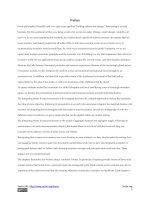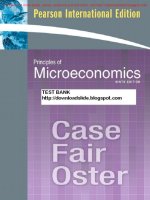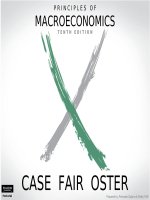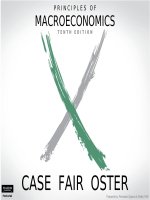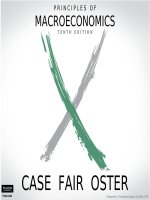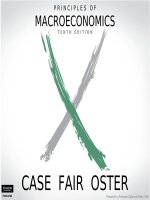Principles of macroeconomics 10e by case fair oster ch02
Bạn đang xem bản rút gọn của tài liệu. Xem và tải ngay bản đầy đủ của tài liệu tại đây (891.39 KB, 53 trang )
PRINCIPLES OF
MACROECONOMICS
PART I Introduction to Economics
TENTH
EDITION
CASE FAIR OSTER
© 2012 Pearson Education, Inc. Publishing as Prentice Hall
Prepared by: Fernando Quijano & Shelly Tefft
PART I Introduction to Economics
© 2012 Pearson Education, Inc. Publishing as Prentice Hall
2 of 53
The Economic
Problem: Scarcity
and Choice
2
CHAPTER OUTLINE
Scarcity, Choice, and
Opportunity Cost
Scarcity and Choice in a One-Person
Economy
Scarcity and Choice in an Economy
of Two or More
The Production Possibility Frontier
The Economic Problem
PART I Introduction to Economics
Economic Systems and the
Role of Government
© 2012 Pearson Education, Inc. Publishing as Prentice Hall
Command Economies
Laissez-Faire Economies: The Free
Market
Mixed Systems, Markets, and
Governments
Looking Ahead
3 of 53
FIGURE 2.1 The Three Basic Questions
PART I Introduction to Economics
Every society has some system or process that transforms its scarce
resources into useful goods and services. In doing so, it must decide
what gets produced, how it is produced, and to whom it is distributed.
The primary resources that must be allocated are land, labor, and
capital.
© 2012 Pearson Education, Inc. Publishing as Prentice Hall
4 of 53
capital Things that are produced and then used in the
production of other goods and services.
PART I Introduction to Economics
factors of production (or factors) The inputs into
the process of production. Another term for resources.
production The process that transforms scarce
resources into useful goods and services.
© 2012 Pearson Education, Inc. Publishing as Prentice Hall
5 of 53
inputs or resources Anything provided by nature or
previous generations that can be used directly or
indirectly to satisfy human wants.
PART I Introduction to Economics
outputs Goods and services of value to households.
© 2012 Pearson Education, Inc. Publishing as Prentice Hall
6 of 53
Scarcity, Choice, and Opportunity Cost
Scarcity and Choice in a One-Person Economy
PART I Introduction to Economics
Nearly all the same basic decisions that
characterize complex economies must
also be made in a simple economy.
© 2012 Pearson Education, Inc. Publishing as Prentice Hall
7 of 53
PART I Introduction to Economics
What is the difference between a single-person economy and a
more complex economy?
a.Most decisions that characterize a complex economy don’t have
to be made by an economy with a single person.
b.Most resources that are scarce in a complex economy are
usually abundant in a simple economy.
c.
In a single-person economy, the concept of opportunity
cost does not apply.
d.
In a single-person economy, the mechanics of decision
making are simpler than those of a more complex economy.
e.
All of the above.
© 2012 Pearson Education, Inc. Publishing as Prentice Hall
8 of 53
PART I Introduction to Economics
What is the difference between a single-person economy and a
more complex economy?
a.Most decisions that characterize a complex economy don’t have
to be made by an economy with a single person.
b.Most resources that are scarce in a complex economy are
usually abundant in a simple economy.
c.
In a single-person economy, the concept of opportunity
cost does not apply.
d.
In a single-person economy, the mechanics of
decision making are simpler than those of a more complex
economy.
e.
All of the above.
© 2012 Pearson Education, Inc. Publishing as Prentice Hall
9 of 53
Scarcity, Choice, and Opportunity Cost
Scarcity and Choice in a One-Person Economy
Opportunity Cost
The concepts of constrained choice and scarcity
are central to the discipline of economics.
PART I Introduction to Economics
opportunity cost The best alternative that we give
up, or forgo, when we make a choice or decision.
© 2012 Pearson Education, Inc. Publishing as Prentice Hall
10 of 53
PART I Introduction to Economics
Using a day at the beach as an example, what is the opportunity cost
of leisure?
a.
Leisure is free. For example, you don’t have to pay for the
benefit of enjoying the sun or relaxing at the beach.
b.
Leisure has an opportunity cost only if there is a cost
associated with it. For example, entering the beach may require you to
pay a fee.
c.
The opportunity cost of leisure at the beach is the value of the
things that you could have produced during the time you were at the
beach. For example, you could have used the time to work and earn
some money.
d.
According to economists, leisure activities are the only
activities that do not carry an opportunity cost.
© 2012 Pearson Education, Inc. Publishing as Prentice Hall
11 of 53
PART I Introduction to Economics
Using a day at the beach as an example, what is the opportunity cost
of leisure?
a.
Leisure is free. For example, you don’t have to pay for the
benefit of enjoying the sun or relaxing at the beach.
b.
Leisure has an opportunity cost only if there is a cost
associated with it. For example, entering the beach may require you to
pay a fee.
c.
The opportunity cost of leisure at the beach is the value
of the things that you could have produced during the time you
were at the beach. For example, you could have used the time to
work and earn some money.
d.
According to economists, leisure activities are the only
activities that do not carry an opportunity cost.
© 2012 Pearson Education, Inc. Publishing as Prentice Hall
12 of 53
E C O N O M I C S I N PRACTI C E
Frozen Foods and Opportunity Costs
The growth of the frozen dinner entrée
market in the last 50 years is a good
example of the role of opportunity costs
in our lives.
PART I Introduction to Economics
Many entrepreneurs find that the simple
tools of economics—like the idea of
opportunity costs—help them anticipate
what products will be profitable for them
to produce in the future.
© 2012 Pearson Education, Inc. Publishing as Prentice Hall
13 of 53
Scarcity, Choice, and Opportunity Cost
Scarcity and Choice in an Economy of Two or More
Specialization, Exchange, and Comparative Advantage
PART I Introduction to Economics
theory of comparative advantage Ricardo’s
theory that specialization and free trade will
benefit all trading parties, even those that may
be “absolutely” more efficient producers.
© 2012 Pearson Education, Inc. Publishing as Prentice Hall
14 of 53
Scarcity, Choice, and Opportunity Cost
Scarcity and Choice in an Economy of Two or More
PART I Introduction to Economics
FIGURE 2.2 Comparative Advantage
and the Gains from Trade
In this figure, (a) shows the number of
logs and bushels of food that Colleen
and Bill can produce for every day
spent at the task
and (b) shows how much output
they could produce in a month,
assuming they wanted an equal
number of logs and bushels.
Colleen would split her time 50/50,
devoting 15 days to each task and
achieving total output of 150 logs
and 150 bushels of food. Bill would
spend 20 days cutting wood and 10
days gathering food.
As shown in (c) and (d), by specializing
and trading, both Colleen and Bill will
be better off. Going from (c) to (d),
Colleen trades 100 logs to Bill in
exchange for 140 bushels of food.
© 2012 Pearson Education, Inc. Publishing as Prentice Hall
15 of 53
Scarcity, Choice, and Opportunity Cost
Scarcity and Choice in an Economy of Two or More
Specialization, Exchange, and Comparative Advantage
PART I Introduction to Economics
absolute advantage A producer has an
absolute advantage over another in the
production of a good or service if he or she can
produce that product using fewer resources.
comparative advantage A producer has a
comparative advantage over another in the
production of a good or service if he or she can
produce that product at a lower opportunity cost.
© 2012 Pearson Education, Inc. Publishing as Prentice Hall
16 of 53
Scarcity, Choice, and Opportunity Cost
Scarcity and Choice in an Economy of Two or More
A Graphical Presentation of Comparative Advantage and Gains from Trade
PART I Introduction to Economics
FIGURE 2.3a Production Possibilities
with No Trade
The figure in (a) shows all of the
combinations of logs and bushels
of food that Colleen can produce
by herself. If she spends all 30
days each month on logs, she
produces 300 logs and no food
(point A).
If she spends all 30 days on food,
she produces 300 bushels of food
and no logs (point B).
If she spends 15 days on logs
and 15 days on food, she
produces 150 of each (point C).
© 2012 Pearson Education, Inc. Publishing as Prentice Hall
17 of 53
Scarcity, Choice, and Opportunity Cost
Scarcity and Choice in an Economy of Two or More
A Graphical Presentation of Comparative Advantage and Gains from Trade
PART I Introduction to Economics
FIGURE 2.3b Production Possibilities
with No Trade
The figure in (b) shows all of the
combinations of logs and bushels
of food that Bill can produce by
himself. If he spends all 30 days
each month on logs, he produces
120 logs and no food (point D).
If he spends all 30 days on food,
he produces 240 bushels of food
and no logs (point E).
If he spends 20 days on logs and
10 days on food, he produces 80
of each (point F).
© 2012 Pearson Education, Inc. Publishing as Prentice Hall
18 of 53
Scarcity, Choice, and Opportunity Cost
PART I Introduction to Economics
Scarcity and Choice in an Economy of Two or More
FIGURE 2.4 Colleen and Bill Gain from Trade
By specializing and engaging in trade, Colleen and Bill can move beyond their own production possibilities. If Bill
spends all his time producing food, he will produce 240 bushels of food and no logs. If he can trade 140 of his bushels
of food to Colleen for 100 logs, he will end up with 100 logs and 100 bushels of food. The figure in (b) shows that he
can move from point F to point F'.
If Colleen spends 27 days cutting logs and 3 days producing food, she will produce 270 logs and 30 bushels of food. If
she can trade 100 of her logs to Bill for 140 bushels of food, she will end up with 170 logs and 170 bushels of food.
The figure in (a) shows that she can move from point C to point C'.
© 2012 Pearson Education, Inc. Publishing as Prentice Hall
19 of 53
Scarcity, Choice, and Opportunity Cost
Scarcity and Choice in an Economy of Two or More
Weighing Present and Expected Future Costs and Benefits
PART I Introduction to Economics
We trade off present and future benefits in small ways all the time.
© 2012 Pearson Education, Inc. Publishing as Prentice Hall
20 of 53
Scarcity, Choice, and Opportunity Cost
Scarcity and Choice in an Economy of Two or More
Capital Goods and Consumer Goods
consumer goods Goods
produced for present consumption.
PART I Introduction to Economics
investment The process of using
resources to produce new capital.
© 2012 Pearson Education, Inc. Publishing as Prentice Hall
21 of 53
Scarcity, Choice, and Opportunity Cost
The Production Possibility Frontier
PART I Introduction to Economics
production possibility frontier (ppf) A
graph that shows all the combinations of
goods and services that can be produced if
all of society’s resources are used efficiently.
© 2012 Pearson Education, Inc. Publishing as Prentice Hall
22 of 53
Scarcity, Choice, and Opportunity Cost
PART I Introduction to Economics
The Production Possibility Frontier
All points below and to the left of
the curve (the shaded area)
represent combinations of capital
and consumer goods that are
possible for the society given the
resources available and existing
technology.
Points above and to the right of the
curve, such as point G, represent
combinations that cannot be
reached.
If an economy were to end up at
point A on the graph, it would be
producing no consumer goods at
all; all resources would be used for
the production of capital. If an
economy were to end up at point B,
it would produce only consumer
goods.
© 2012 Pearson Education, Inc. Publishing as Prentice Hall
23 of 53
Scarcity, Choice, and Opportunity Cost
PART I Introduction to Economics
The Production Possibility Frontier
Although an economy may be
operating with full employment of its
land, labor, and capital resources, it
may still be operating inside its ppf,
at a point such as D. The economy
could be using those resources
inefficiently.
Periods of unemployment also
correspond to points inside the ppf,
such as point D.
Moving onto the frontier from a
point such as D means achieving
full employment of resources.
© 2012 Pearson Education, Inc. Publishing as Prentice Hall
24 of 53
Scarcity, Choice, and Opportunity Cost
The Production Possibility Frontier
PART I Introduction to Economics
FIGURE 2.5 Production Possibility
Frontier
The ppf illustrates a number of
economic concepts. One of the
most important is opportunity
cost. The opportunity cost of
producing more capital goods is
fewer consumer goods.
Moving from E to F, the number
of capital goods increases from
550 to 800, but the number of
consumer goods decreases
from 1,300 to 1,100.
© 2012 Pearson Education, Inc. Publishing as Prentice Hall
25 of 53

